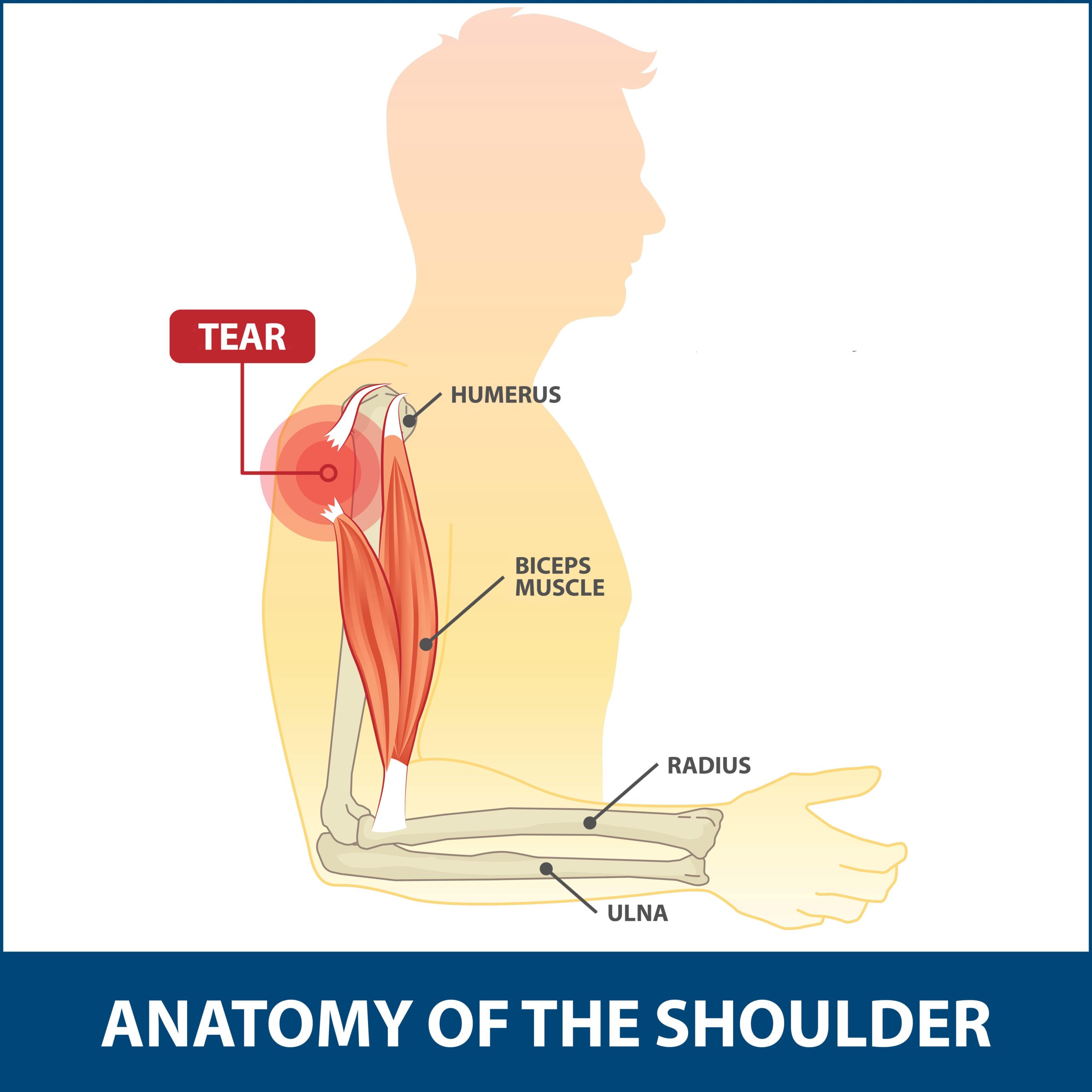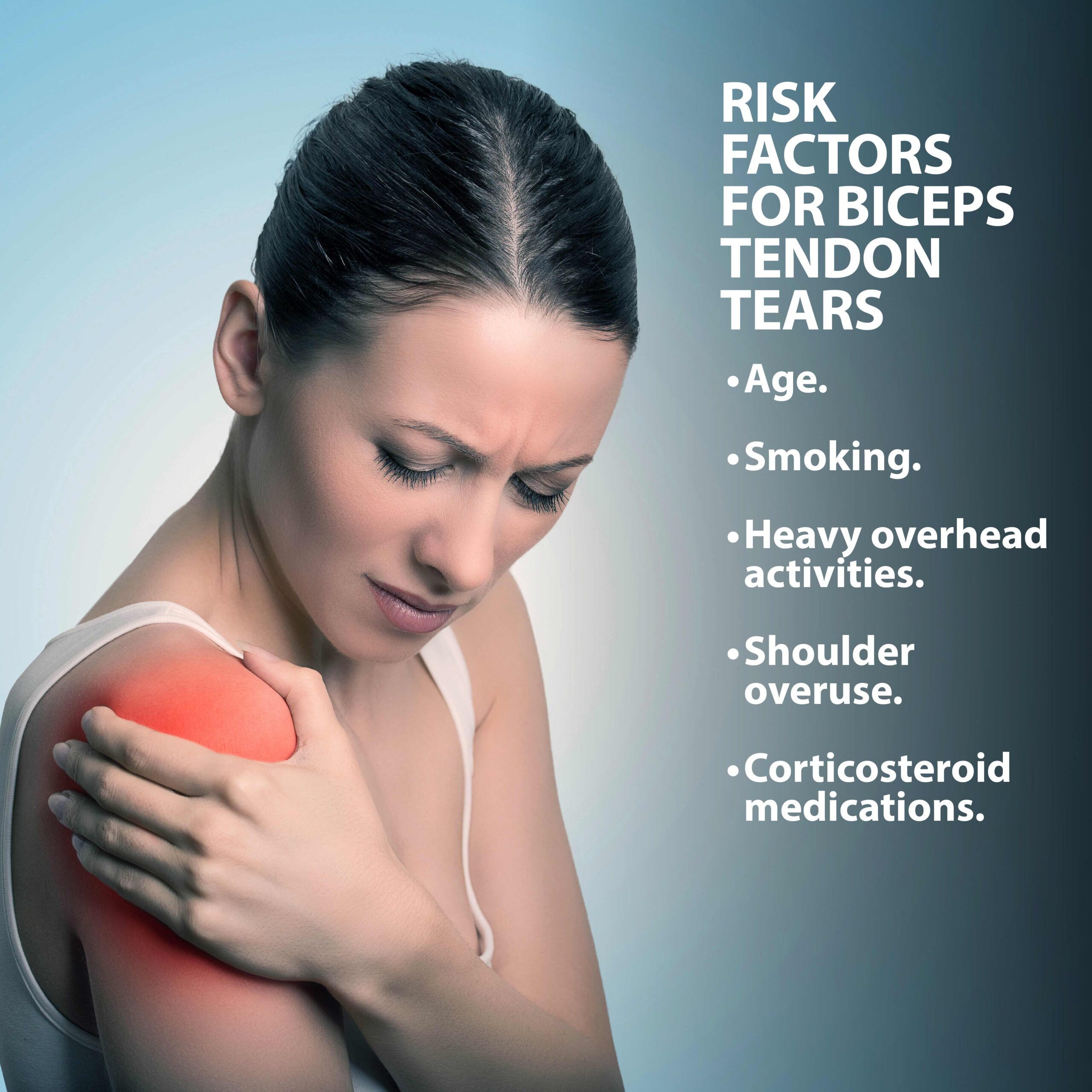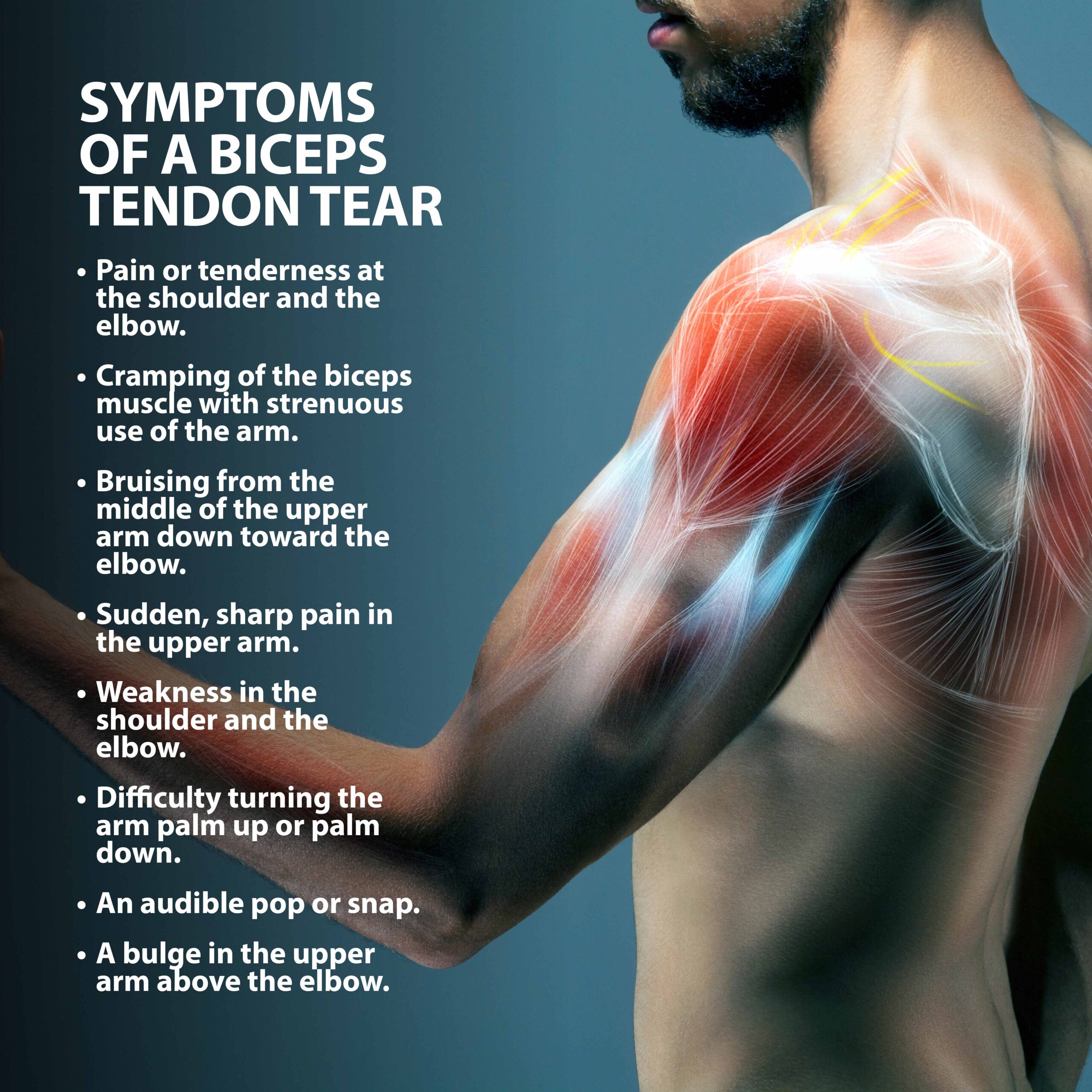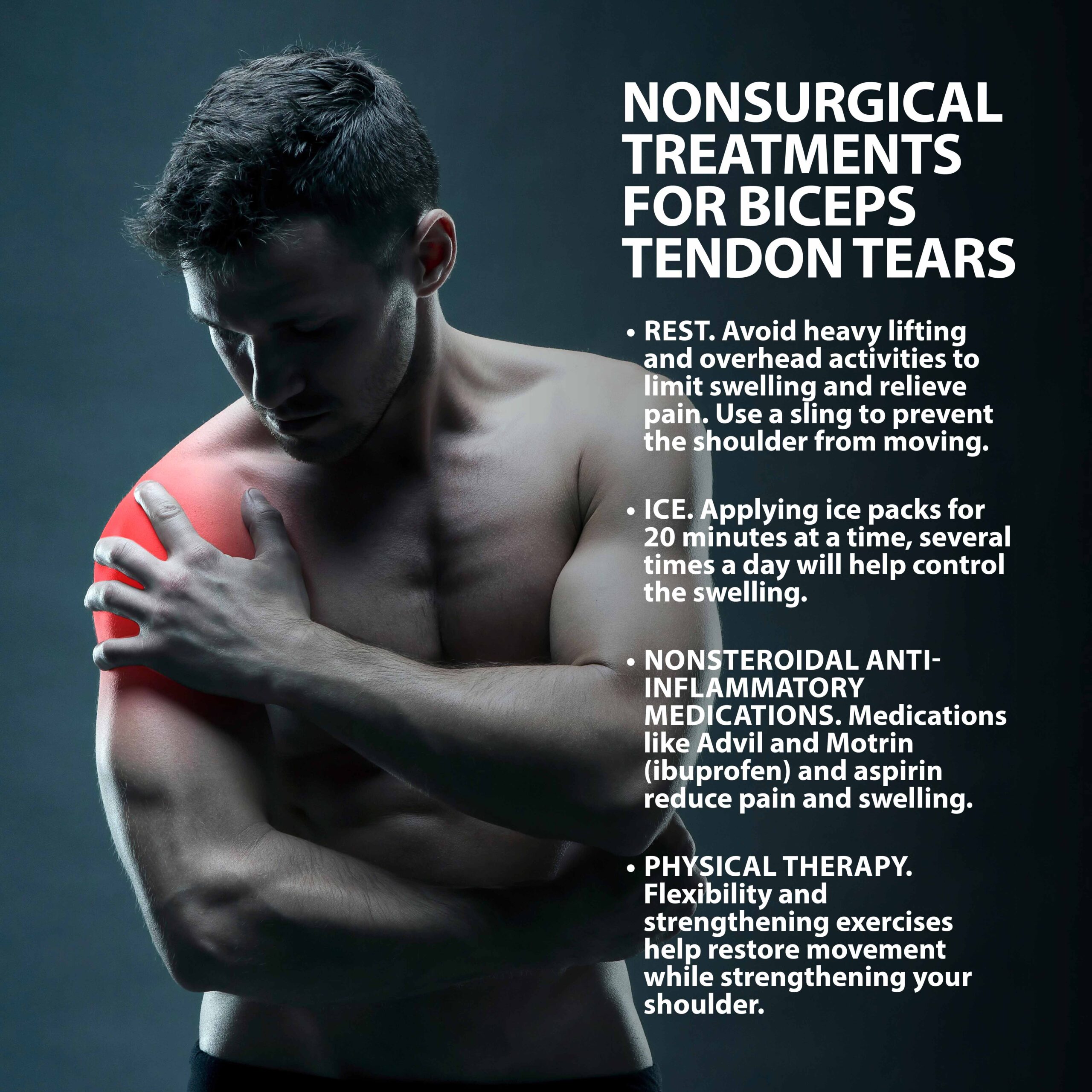Bicep Tendon Tear
OVERVIEW
A bicep tendon tear at the shoulder occurs due to either abrupt injury or overuse over time. The tendon itself can either tear partially or entirely. Most people will be able to continue living their lives without ever having to get surgery. A biceps tendon tear will cause you to lose some strength and mobility in your shoulder, but usually not enough to make a difference in your daily activities. But people who need to regain full mobility and strength of the shoulder will need to get surgery. Recovery is often a lengthy process, but most people can return to their daily activities.
ANATOMY
Your shoulder is a ball-and-socket joint that consists of 3 bones: your collarbone (clavicle), your shoulder blade (scapula), and your upper arm bone (humerus). The head of your upper arm bone fits into a rounded socket (known as the glenoid) in your shoulder blade. A combination of tendons and muscles (known as the rotator cuff) help keep your arm bone centered in your shoulder socket. The upper end of the biceps muscle has two tendons that attach it to the bones in the shoulder. The long head connects to the top of the shoulder socket (glenoid). The short head attaches to a bump on the shoulder blade called the coracoid process.

DESCRIPTION
Your biceps tendon attaches the biceps muscle to bones in the shoulder and elbow. If you tear the biceps tendon at the shoulder, you run the risk of losing some strength in your arm and may have pain when forcefully turning your arm from palm down to palm up. Most people can still function with a biceps tendon tear and only need simple treatments to relieve symptoms.
There are two types of biceps tendon tears: partial and complete. Partial tears do not completely sever the tendon, while complete tears completely sever the tendon. In most cases, torn tendons start by fraying. As the damage progresses, the tendon can completely tear, sometimes triggered by lifting heavy objects.
When you tear your biceps tendon, you can also damage other parts of your shoulder, such as the rotator cuff tendons.
CAUSES
Bicep tendon strains or tears usually occur from sudden events or over time. Sudden (acute) injuries typically result from events like car accidents, falls from significant distances, or when people use their arms or shoulders to cushion a fall.
Chronic (ongoing) issues also commonly happen. Often, they result from participation in sports or professions requiring continual pressure or forceful contact on the arm and shoulder. Over time, the tendon wears down from overuse and can tear.
RISK FACTORS
An individual’s risk of sustaining a bicep tendon tear increases if they participate in full-contact sports like football or use continual throwing motions like baseball and softball. Those employed in jobs like painting, construction, and plumbing also stand at a higher risk because they often use their arms and shoulders while engaging in forceful hand and arm movements to do specific tasks.
One’s chances also rise if they have circulation issues limiting blood supply to their arms or shoulders, once sustained any shoulder or arm injury, or smoke, as cigarette smoke elevates the body’s carbon monoxide levels. Smoking limits blood levels of oxygen, which makes soft tissues more vulnerable to injury and significantly reduces healing time.
Other risk factors include:
- Age. Older people will have put more years of wear and tear on their tendons, making their tendons more susceptible to ripping.
- Smoking. Smoking can affect nutrition in the tendon, making it weak and easier to tear.
- Heavy overhead activities. Too much load during weightlifting, for example, can cause the tendon to rip.
- Corticosteroid medications. These medications are linked to increased muscle and tendon weakness.

SYMPTOMS
The symptoms associated with a bicep tendon tear include:
- Pain or tenderness at the shoulder and the elbow.
- Cramping of the biceps muscle with strenuous use of the arm.
- Bruising from the middle of the upper arm down toward the elbow.
- Sudden, sharp pain in the upper arm.
- Weakness in the shoulder and the elbow.
- Difficulty turning the arm palm up or palm down.
- An audible pop or snap in the shoulder.
- Since a torn tendon loses the ability to keep the biceps muscle tight, a bulge in the upper arm above the elbow may appear, with a dent near the shoulder.

DIAGNOSIS
Your Florida Orthopaedic Institute physician will look at your symptoms and medical history, then examine your shoulder. In most cases, determining a complete tear is obvious since it causes a deformity in the arm muscle. Partial ruptures are less noticeable. Your physician may ask you to bend your arm and tighten the biceps muscle. You may have a biceps tendon tear if you feel pain during these movements.
Your physician may also order several tests to confirm that you have a biceps tendon tear, not another condition or injury. These tests include:
- X-rays. This diagnostic test helps rule out other problems that can cause shoulder and elbow pain.
- Magnetic Resonance Imaging (MRI). These scans create better images of soft tissues and can show both partial and complete tears.
TREATMENT OVERVIEW
Since many people can usually function with a bicep tendon tear, usually only non-surgical, simple treatments are needed to relieve symptoms. If symptoms do not improve, or if you need a complete recovery of strength, surgery to repair the torn tendon may be necessary.
NON-SURGICAL TREATMENT
For many people, pain from a bicep tendon tear goes away over time. There are some things you can do to help lessen the time it takes for the pain to recede, including:
- Rest. Avoid heavy lifting and overhead activities to limit swelling and relieve pain. Your Florida Orthopaedic Institute physician may recommend using a sling for a short period to prevent the shoulder from moving.
- Ice. Applying ice packs for 20 minutes at a time, several times a day will help control the swelling. Never apply ice directly to the skin.
- Nonsteroidal Anti-Inflammatory Medications. Medications like Advil and Motrin (ibuprofen) and aspirin reduce pain and swelling.
- Physical Therapy. Flexibility and strengthening exercises help restore movement while strengthening your shoulder.

SURGICAL TREATMENT
Surgical treatment is rarely needed to heal a biceps tendon tear. Some people who develop muscle cramping or need a complete recovery of strength, like athletes or manual laborers, may need surgery.
Several new procedures can repair the tendon with minimal incisions. The procedures generally consist of re-anchoring the torn tendon to the bone. Your Florida Orthopaedic Institute physician will discuss your options with you.
RECOVERY
After the procedure, your shoulder may be immobilized with a sling for a brief period. Afterward, your physician will soon start you on therapeutic exercises. These exercises will improve flexibility and the range of motion of your shoulder. Recovery will be slow, but eventually, you will regain full shoulder movement. The pace at which one recovers from a bicep tendon strain or tear will hinge on several key factors, including:
- Age.
- Fitness levels.
- The injury’s specific location and grade severity.
- The injured person’s general health and long-term recovery goals.
- The specific treatment type used.
Even mild strains may take several weeks or months to heal completely. Those requiring more aggressive efforts like surgery and physical therapy may take months to return to their previous strength. Recovering individuals return to previous activities gradually as the damaged soft tissues improve.
PREVENTION
Prevention is not always possible. You may reduce your chances of developing a bicep tendon injury through measures such as:
- Engaging in exercises that strengthen hand, elbow, arm, and shoulder muscles.
- Using caution when lifting heavy objects.
- Limiting exposure to forceful or unnecessary physical contact.
- Refraining from using steroids as these drugs have been known to weaken soft tissues.
Above all, persons are urged not to overtax themselves, stop exercise or potentially harmful actions or movements when bicep pain develops, and seek immediate medical evaluation and treatment.
NEXT STEPS
Regardless of your treatment plan, following your physician’s plan to recover fully is important. Although it can be a slow process, your commitment to your treatment plan is the most crucial factor in returning to all the activities you enjoy.
Contact your Florida Orthopaedic Institute physician today for more information.
DOWNLOAD OUR DOCTOR QUESTIONNAIRE
Download our free questionnaire “10 Questions To Ask Your Doctor About Bicep Tendon Tears.”

Areas of Focus
- Shoulder
- AC Joint Injuries
- Atraumatic Shoulder Instability
- Bankart Repair
- Bicep Tendon Tear
- Bicep Tenodesis
- Broken Collarbone
- Bursitis of the Shoulder (Subacromial Bursitis)
- Calcific Tendinitis of the Shoulder
- Clavicle Fractures
- Dislocated Shoulder
- Fractures Of The Shoulder Blade (Scapula)
- Glenoid Labrum Tear
- Impingement Syndrome of the Shoulder
- Little League Shoulder
- Reverse Total Shoulder Replacement
- Rheumatoid Arthritis (RA) of the Shoulder
- Rotator Cuff Tears
- Shoulder Arthritis
- Shoulder Arthroscopy
- Shoulder Injury: Pain In The Overhead Athlete
- Shoulder Replacement
- Shoulder Separations
- Shoulder Socket Fracture (Glenoid Fracture)
- SLAP Tears & Repairs
- Subacromial Decompression
- Trapezius Strain (Muscle Strain of The Upper Back)
- Traumatic Shoulder Instability
The following Florida Orthopaedic Institute physicians specialize in Bicep Tendon Tear:
Specialties
- AC Joint Injuries
- Achilles Tendinitis - Achilles Insertional Calcific Tendinopathy (ACIT)
- Achilles Tendon Rupture
- Achilles Tendonitis
- ACL Injuries
- Ankle Fracture Surgery
- Ankle Fractures (Broken Ankle)
- Ankle Fusion Surgery
- Anterior Cervical Corpectomy & Discectomy
- Arthroscopic Articular Cartilage Repair
- Arthroscopic Chondroplasty
- Arthroscopic Debridement of the Elbow
- Arthroscopy Of the Ankle
- Articular Cartilage Restoration
- Artificial Disk Replacement (ADR)
- Aspiration of the Olecranon Bursa - Fluid In Elbow
- Atraumatic Shoulder Instability
- Avascular Necrosis (Osteonecrosis)
- Bankart Repair
- Basal Joint Surgery
- Bicep Tendon Tear
- Bicep Tenodesis
- Bone Cement Injection
- Bone Growth Stimulation
- Bone Health Clinic
- Broken Collarbone
- Bunions
- Bursitis of the Shoulder (Subacromial Bursitis)
- Calcific Tendinitis of the Shoulder
- Carpal Tunnel Syndrome
- Charcot Joint
- Chiropractic
- Clavicle Fractures
- Colles’ Fractures (Broken Wrist)
- Common Foot Fractures in Athletes
- Community Outreach
- Cubital Tunnel Syndrome
- De Quervain's Tenosynovitis
- Deep Thigh Bruising
- Degenerative Disk Disease
- Diffuse Idiopathic Skeletal Hyperostosis (DISH)
- Discectomy
- Discitis Treatment & Information
- Dislocated Shoulder
- Dupuytren’s Disease
- Elbow
- Elbow Bursitis
- Elbow Injuries & Inner Elbow Pain in Throwing Athletes
- Epidural Injections for Spinal Pain
- Finger Dislocation
- Flexor Tendonitis
- Foot Stress Fractures
- Foot, Ankle & Lower Leg
- Foraminotomy
- Fractured Fingers
- Fractures Of The Shoulder Blade (Scapula)
- Fractures Of The Tibial Spine
- Functional Nerve Transfers of The Hand
- Ganglion Cysts
- General Orthopedics
- Glenoid Labrum Tear
- Golfer's Elbow
- Groin Strains and Pulls
- Growth Plate Injuries Of The Elbow
- Hallux Rigidus Surgery - Cheilectomy
- Hammer Toe
- Hamstring Injuries
- Hand & Finger Replantation
- Hand & Wrist
- Hand Nerve Decompression
- Hand Skin Grafts
- Hand, Wrist, Elbow & Shoulder
- Heat Injury/Heat Prostration
- High Ankle Sprain (Syndesmosis Ligament Injury)
- Hip & Thigh
- Hip Arthroscopy
- Hip Dislocation
- Hip Flexor Strains
- Hip Fractures
- Hip Hemiarthroplasty
- Hip Impingement Labral Tears
- Hip Muscle Strains
- Hip Pointers and Trochanteric Bursitis
- Hyperextension Injury of the Elbow
- Iliopsoas Tenotomy
- Iliotibial Band Syndrome
- Impingement Syndrome of the Shoulder
- Interlaminar Implants
- Interlaminar Lumbar Instrumental Fusion: ILIF
- Interventional Pain Management
- Interventional Spine
- Intraarticular Calcaneal Fracture
- Joint Replacement
- Knee & Leg
- Kyphoplasty (Balloon Vertebroplasty)
- Kyphosis
- Labral Tears Of The Hip (Acetabular Labrum Tears)
- Laminectomy: Decompression Surgery
- Lateral Collateral Ligament (LCL) Injuries
- Lisfranc Injuries
- Little League Shoulder
- LITTLE LEAGUER'S ELBOW (MEDIAL APOPHYSITIS)
- Lumbar Epidural Steroid Injection
- Lumbar Interbody Fusion (IBF)
- MACI
- Mallet, Hammer & Claw Toes
- Medial Collateral Ligament Injuries
- Meniscus Tears
- Metatarsalgia
- Minimally Invasive Spine Surgery
- Morton’s Neuroma
- Muscle Spasms
- Muscle Strains of The Calf
- Nerve Pain
- Neuromas (Foot)
- Neurosurgery
- Olecranon Stress Fractures
- Orthopaedic Total Wellness
- Orthopaedic Trauma
- Orthopedic Physician Or A Podiatrist? Definition of a Podiatrist
- Osteoarthritis of the Hip
- Osteoporosis
- Outpatient Spine Surgery
- Partial Knee Replacement
- Patellar Fracture
- Pelvic Ring Fractures
- Peripheral Nerve Surgery (Hand) Revision
- Pinched Nerve
- Piriformis Syndrome
- Piriformis Syndrome
- Plantar Fasciitis
- Plastic Surgery
- Podiatry
- Primary Care Sports Medicine
- Quadriceps Tendon Tear
- Radial Tunnel Syndrome (Entrapment of the Radial Nerve)
- Revascularization of the Hand
- Reverse Total Shoulder Replacement
- Rheumatoid Arthritis (RA) of the Shoulder
- Rheumatoid Arthritis Of The Hand
- Robotics
- Rotator Cuff Tears
- Runner's Knee
- Sacroiliac Joint Pain
- Sciatica
- Scoliosis
- Senior Strong
- Shin Splints
- Shoulder
- Shoulder Arthritis
- Shoulder Arthroscopy
- Shoulder Injury: Pain In The Overhead Athlete
- Shoulder Replacement
- Shoulder Separations
- Shoulder Socket Fracture (Glenoid Fracture)
- SLAP Tears & Repairs
- Spinal Fusion
- Spine
- Spondylolisthesis and Spondylolysis
- Sports Foot Injuries
- Sports Hernias (Athletic Pubalgia)
- Sports Medicine
- Sports Wrist and Hand Injuries
- Sprained Ankle
- Sprained Wrist Symptoms and Treatment
- Subacromial Decompression
- Sudden (Acute) Finger, Hand & Wrist Injuries
- Targeted Muscle Reinnervation (TMR)
- Tendon Transfers of The Hand
- Tennis Elbow Treatment
- Thigh Fractures
- Thigh Muscle Strains
- Thumb Ulnar Collateral Ligament Injuries
- Total Ankle Replacement
- Total Hip Arthroplasty
- Total Hip Replacement - Anterior Approach
- Total Knee Replacement Surgery
- Trapezius Strain (Muscle Strain of The Upper Back)
- Traumatic Shoulder Instability
- Tricep Pain & Tendonitis
- Trigger Finger
- Turf Toe
- UCL (Ulnar Collateral Ligament) Injuries
- Ulnar Neuritis
- Valgus Extension Overload
- Vertebroplasty
- WALANT (Wide Awake Local Anesthesia No Tourniquet)
- Whiplash and Whiplash Associated Disorder (WAD)
- Wound Care
- Wrist Arthroscopy
- Wrist Fractures
- Wrist Tendonitis
Services
- Physical Medicine & Rehabilitation
- Physical Therapy
- Primary Care Sports Medicine
- PROMs (Patient-Reported Outcome Measures)
- Same-Day Orthopaedic Appointments Now Available
- Sports Medicine
- Sports-Related Concussion Treatment
- Telehealth Page
- Telemedicine
- Workers' Compensation
- Workers' Compensation Dispensary
- X-Ray
